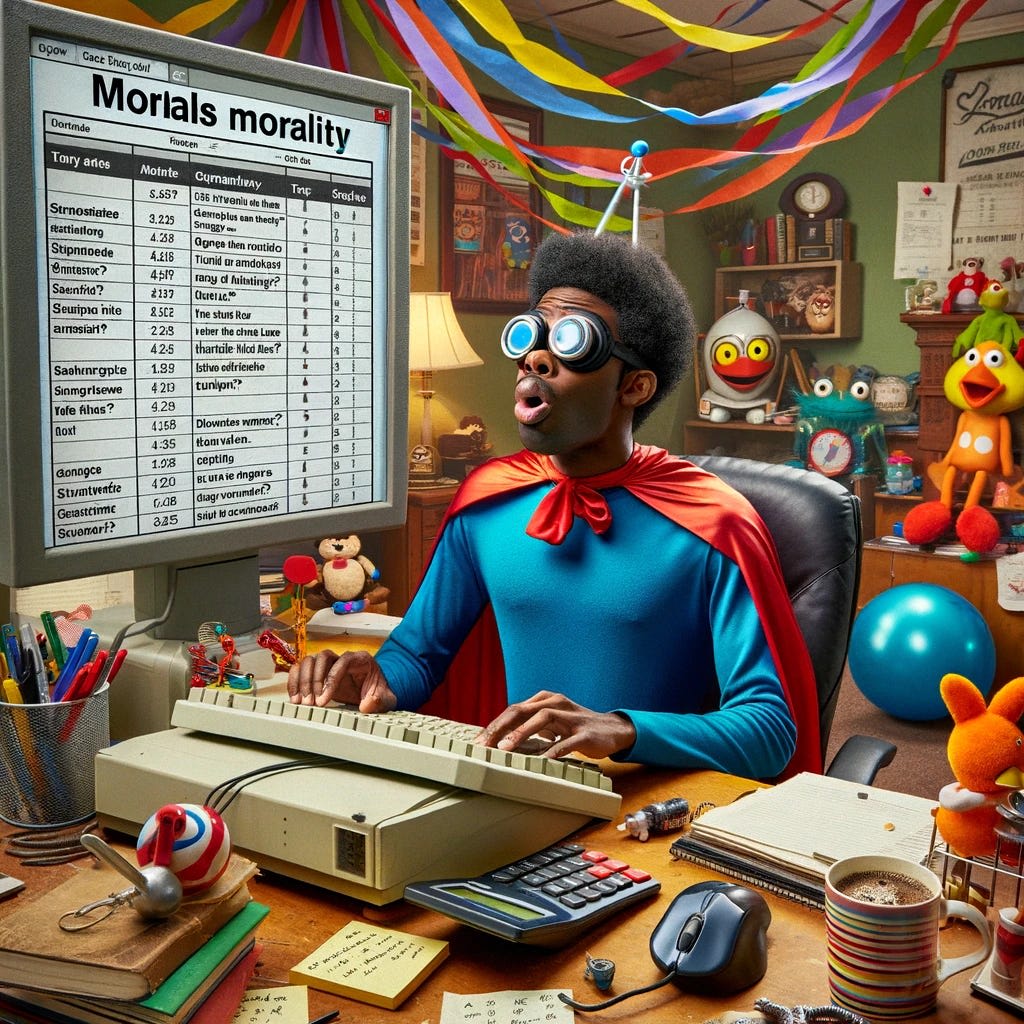[Cross-posted from my blog]
A common criticism of effective altruism (EA) is its tendency to oversimplify complex issues into mere numbers. Critics argue that EA approaches amount to calculating moral decisions as if on a spreadsheet. They protest that you can’t put a number on human life or the impact of a charity because not everything can be quantified.
I disagree with these objections. I think they miss the fundamental purpose of quantification. Quantifications are not intended to be literally true; they are supposed to be a useful framework to guide decision-making. In this context, their utility is unmatched.

Mathematical theory is precise and logical, leading to exact answers. For example, if you start with three apples, add three more, eat four, then add one, you’re back to three apples again, exactly where you started. But, in reality, no two apples are identical, so you’re not exactly where you started. This doesn't imply that the mathematical model “doesn’t work”; it simply means its application has limits. It counts the apples accurately but doesn't account for their uniqueness.
This limited nature is true of all models. As the statistician George Box said, “All models are wrong, some are useful.” Economists, for instance, rely on price not because it perfectly reflects value, but because it is a highly useful tool for quantification. Money, as a universal quantifier, is incredibly helpful, yet it also has its limitations. It facilitates transactional clarity, even though it may not capture the full spectrum of value in every context.
Imagine two companies, Alfred's Apples and Bonnie's Bananas, both seeking loans from a bank. Alfred's Apples dominates the lucrative apple market, while Bonnie's Bananas is a major player in the less profitable banana market. Comparing these companies for loan purposes is challenging due to their different products. This is where money becomes a crucial tool.
By quantifying the worth of Alfred’s Apples at $100M and Bonnie’s Bananas at $50M, the bank can compare them on a common scale and decide on loan terms. Moreover, once these companies are on the stock market, their valuations reflect the collective judgment of all investors, condensed into a single number per company.
This process, where everything is converted to monetary value, allows us to aggregate and compare diverse entities. It allows for a global consensus on the value of publicly traded companies. Arguably, this system is one of the most efficient information processing systems to have ever existed on the planet.
That’s all well and good for apples and bananas, but what about human lives? Again, the exact same thing is true: quantification is a tool that can help us answer questions, but it has limits.
Government agencies often face challenging decisions where they must weigh the cost against the potential for saving lives. To facilitate this, they assign a monetary value to a statistical human life. For example, the EPA uses a value of $7.4 million (in 2006 dollars), while the Department of Transportation uses $9.1 million. The exact figure isn't as crucial as the fact that there is a number. This allows agencies to evaluate life-saving investments more systematically. This allows them to look at every potentially lifesaving investment and say, “Find out how many lives it would save. Find out how much it would cost. Now find the cost per life and let’s look in more detail at the proposals where the cost is below $10 million.” This approach provides a practical framework for assessing the cost-effectiveness of various safety measures.
This does not mean that “a human life is worth $9.1 million.” No one is saying that. They are, however, saying that quantifying it as such is a useful tool. The EPA’s website that lists the $7.4 million number, in anticipation of criticism, makes this explicit:
The EPA does not place a dollar value on individual lives. Rather, when conducting a benefit-cost analysis of new environmental policies, the Agency uses estimates of how much people are willing to pay for small reductions in their risks of dying from adverse health conditions that may be caused by environmental pollution.
While some may object to the practice of assigning a monetary value to human life, in practical terms, we implicitly understand that such a valuation is inevitable. The belief that human life is priceless is a fundamental ethical stance, yet it conflicts with practical limits in decision-making. Consider an extreme scenario: would it be feasible to spend a trillion dollars to save a single life? Most would say no. Conversely, spending one dollar to save a life would be an unequivocal yes. This suggests that the value of a life, though immeasurable in moral terms, falls somewhere between these two extremes in practical scenarios.
Caveats and clarifications:
- Yes, there’s more to life than being alive.
- Yes, some improvements are worthwhile but don’t save lives.
- No, I would not be willing to sell my life for $10 million.
Quantifying the value of a statistical life doesn’t dispute any of these statements. It's just a framework to get started.
OK, but how do you quantify questions of moral goodness? Philosophers have long grappled with this issue, yet a definitive answer remains elusive. This doesn’t have to paralyze decision-making. For example, let’s compare the value of preventing blindness versus giving a guide dog to a blind person. My guess is most people would say preventing blindness is more valuable. Some might believe curing blindness is twice as valuable, others might value it ten times more, while some see both actions as equally important. Despite the disagreement, we can still ask each person how they would rank a charity that trained guide dogs and one that cured blindness. According to philosopher Peter Singer’s Ted Talk, “It costs about 40,000 dollars to train a guide dog and train the recipient so that the guide dog can be an effective help to a blind person. It costs somewhere between 20 and 50 dollars to [prevent] a blind person in a developing country if they have trachoma.” Even if you think these numbers are off, or you think training a guide dog is 10 times more valuable than curing blindness, you would still conclude that curing blindness is a more effective investment. This example illustrates that, despite disagreements in moral valuation, we can still use quantifiable data to inform our decisions about charitable effectiveness."
Just to be absolutely clear, my argument isn't that providing guide dogs to blind people is not valuable. If it seems like I'm suggesting that, then the point has been misunderstood. The comparison between preventing blindness and training guide dogs was to illustrate the complexities and considerations in evaluating the effectiveness of different charitable actions. It's not about devaluing one noble cause in favor of another, but about exploring how we can make informed decisions when resources are limited.
It's crucial to recognize the limitations of quantification. Take the earlier example of Alfred's Apples and Bonnie's Bananas, where Alfred's company is valued at twice that of Bonnie's. This valuation doesn’t mean that splitting Alfred’s company in half would create two entities comparable to Bonnie’s Bananas, even though they might be monetarily “equivalent”. That would be extending quantification beyond its logical and useful scope.
Similarly, when quantifying ethical decisions, it's important to note that not all mathematical principles directly translate. For instance, performing a good deed today doesn't provide a moral license to commit a smaller bad deed in the future. This is another case where a literal interpretation of quantification can be misleading.

The key point is not that quantification provides perfect answers, but that it can be a useful aid in decision-making. Its value lies in utility rather than absolute truth. A human life isn't worth $10 million. There's no such thing as -1 apples. If you accidentally donated more money than you meant to a charity, it doesn’t mean you’re now allowed to go knock over an old lady crossing the street to balance things out. No one is advocating for such literal interpretations.
Both supporters and critics need to remember that quantification is merely a tool. Overemphasizing its importance can lead to missteps. It’s not perfect and has limitations. However, dismissing it entirely would be a mistake, as it can provide valuable insights and guidance in many scenarios. The balance lies in using this tool wisely, understanding its scope, and acknowledging its limitations.